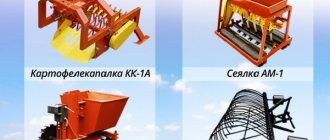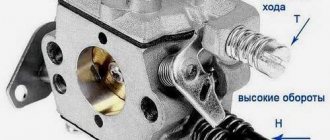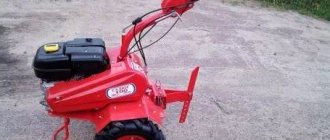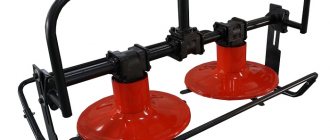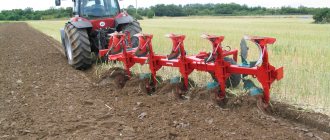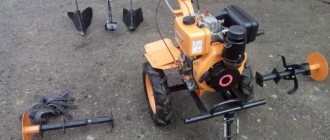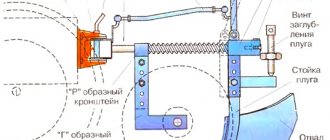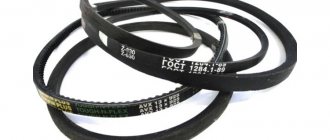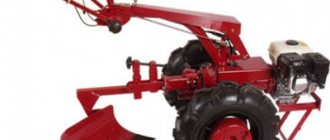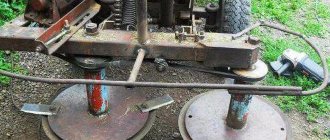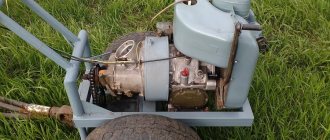Benefits of using a plow
Using mechanical tools to plow a field greatly simplifies farm work. According to statistics, the yield almost doubles if the field is processed using specialized devices.
The following are the advantages of using motorized plows:
- saving time and getting better results by applying a minimum of effort;
- additional loosening of the soil and subsequent fertilization using one tool;
- uniform cultivation of the land and, as a result, improved structural quality and condition;
- saturation of the soil with moisture and oxygen;
- slowing down the growth of weeds through land cultivation.
Plowing a garden with a walk-behind tractor: preparing equipment
How to plow with a walk-behind tractor correctly?
It is quite simple if all preparatory procedures are followed.
To effectively plow a field, you need to choose the right walk-behind tractor. The model and dimensions directly depend on the area of the land plot, as well as the required operations. There are three main subtypes of blocks:
- small;
- average;
- big;
Some of the most functionally simple and lightweight devices have an engine power of up to 4.5 horsepower. Their weight does not exceed 40 kg, and cost no more than $300. Thanks to their small dimensions, they are maneuverable and easy to control. Due to the small grip of the cutter, hard-to-reach areas can be easily processed.
Medium walk-behind tractor
goes beyond the category of devices for processing personal areas. The presence of rear-wheel drive allows you to work on fields up to 0.5 hectares in size. Their weight ranges from 45 kg to 65 kg, the cost does not exceed $600. The main functions are performed by an engine with a power of up to 12 horsepower.
Many models allow you to process fields at different speeds, controlled by a gearbox. Work in the evening is carried out thanks to the built-in headlights. One of the disadvantages is the shallow cultivation depth of up to 11 cm. This is not enough for many crops, so the devices are classified as amateur and not classified as professional.
The largest type of blocks
used for working on fields larger than 0.5 hectares. Engine power - from 10 to 30 horsepower. In addition to the trailer, a potato digger is attached. Multicultivators do not cultivate the ground at the same speed as a connected plow or trailer. The advantages include adjusting the steering wheel according to the height of the farmer, reverse, and adjusting the pneumatic wheel. The devices are quite heavy compared to conventional models, so the farmer requires appropriate physical training and experience.
Before plowing
wheels with a diameter of 50−60 cm and a width of 18−20 cm are hung. It is important to observe these parameters; if the wheels are too narrow, there is a possibility that the tool will swing from side to side. An insufficiently large diameter will create a small distance between the soil and the gearbox. If the rim is solid, the likelihood of soil collecting in the lug ribs increases.
You will need a partner to hang the equipment. It will help to lift the equipment and place it on stands, to a recommended height of 15-20 cm. In this case, the edge of the ploughshare should touch the ground. The plow stand is positioned vertically, and the beam is installed in a horizontal position. The right edge is installed in line with the inner edge of the right wheel. This ensures even cutting of the soil, easy falling off and smooth running of the walk-behind tractor. Before carrying out operations, you should consult the manufacturer's instructions.
Soil preparation
A cord is stretched along the ground
, which serves as a guide for further movement. It is usually installed on the first row. These rules help inexperienced plowmen maintain a landmark, since the plow leads to the side. On the second row the cord is removed. As a rule, a person who has already done similar types of work has no problems maintaining the required distances and making all the rows even.
Working with land
After preliminary preparation, plowing begins. For fewer unnecessary movements, the walk-behind tractor goes along the side that is larger. This allows you to make fewer turns, which saves both the worker’s effort and the time spent redefining the direction of the block. The handle rotates to the left for ease of movement on unplowed ground. It is important to maintain a moderate pace of movement of the block to prevent the motor from heating up. In case of overheating, operation is suspended until the unit cools down. It is also not recommended to push the plow.
Each field is unique
and has different soil hardness. The normal quality of the soil is looseness, in which the soil can easily be pierced with a metal stick to a depth of 50 cm. Hard soil makes it difficult for the plowing machine to move and negatively affects the serviceability and further performance of the tool. In this case, the soil is moistened with ordinary water or special solutions, and the plot is passed through twice. The first is preparatory, and the second is used for plowing to full depth. In some cases, you should consolidate the result and go through it a third time.
Setting up a walk-behind tractor
Working with a walk-behind tractor begins with setting it up. It depends, first of all, on the area of the plowed area, as well as on the quality of the soil. Some universal rules will help you set up your equipment correctly:
- The recommended diameter of the lugs is 50-60 cm, and the width is 18-20 cm. If the dimensions are smaller than those specified, the equipment will not make it possible to make an even furrow; it will be driven on different sides.
- It is preferable to choose a solid wheel rim so that earth does not accumulate on it.
- The weight of the unit must be less than 70 kg, otherwise it will constantly slip.
- The position of the machine itself when plowing should be such that its entire base is completely in contact with the soil. Otherwise, the plowing depth will either be too great, or, conversely, plowing will not work at all.
- When attaching the plow to the coupling device, the fastening nuts are not fully tightened. This leaves the possibility of further regulation. Using just two pins, you can easily connect the plow to the mounting eyelet.
We invite you to familiarize yourself with the Domestic pig - care features and breeding rules (video 115 photos)
Important clarifications
Plowing with a walk-behind tractor occurs vertically; when it begins to deviate, the farmer, using his own strength, redirects it in the right direction and then monitors the correct movement of the tool. To make this task easier, the nuts in the adjustment groove are loosened and tightened again when finished.
Walk-behind tractors are often used for hilling potatoes.
, for which they attach another attachment - a hiller. It cuts the ground to the same depth as a plow. There are two types: regular and disk. More convenient to use is the disc-shaped one, but it is significantly more expensive.
The walk-behind tractor is known as a convenient tool for harvesting. Instead of a hiller or plow, an object is hung, which is a mixture of weeding paws and a lattice. His job is that he lifts the ground, takes root crops and pours the soil back so that the harvested crop remains on the surface.
Once you have a hectare, do not plow your land with a tractor. The sight of the overturned earth, which then spreads into mush from the rains and, when dried, becomes hard like concrete - a disgusting sight. Non-mouldboard methods of loosening are also bad: the walk-behind tractor turns the soil into dust, cuts worms along the way and is wrapped in weeds, which are left on the beds as fertilizer. Try not to touch the ground. At all. One winter, as an experiment. In spring the earth will become soft as feathers! You can easily insert your palm into it to its full depth. The fact is that the water in the soil, freezing, breaks it into small grains. In spring, the ice melts and the water goes underground, and the space between the grains is filled with air. It is not digging that makes the ground soft, but frost! Note to the housewife: you can speed up the formation of humus by quickly freezing manure and other organic materials with dry ice or liquid nitrogen before adding them to the soil. This is especially useful in areas where winter is purely symbolic or in apartments. A shovel is only needed for digging potatoes and planting holes. Fears that without plowing and digging the garden will be overgrown with perennial weeds will not be justified! After a few years, you will notice that the garden is literally teeming with earthworms. But the joy will be short-lived: after the worms will come those who feed on worms - moles. They will plow the garden up and down, hopelessly ruining all the plantings. Do not use chemical poison (it is harmful to plants and your health. Voles and hamsters overwinter freely on unplowed land and destroy up to a quarter of the entire crop and gnaw the foundations of houses (tested in a real settlement). To prevent rodents from growing in the garden, you need to plant blackroot, several There are more than enough bushes to make you forget about rodents forever.It doesn’t hurt to plant blackroot next to fruit trees, because they also suffer from rodents and hares in winter.
You can fight rodents with humane mousetraps, boiling water, gas, hedgehogs and cats. Rodents are needed because they loosen the earth (first) and secondly, because bumblebees live in their burrows, and bumblebees are good pollinators. An excess of rodents is harmful to some, a deficiency to others. Conclusion: Maintain a reasonable balance of rodents, cats, hedgehogs and bumblebees in your ecosystem. Perhaps the problem of bumblebees will be solved by a bee hive or wasp nests in wooden wasp houses; It is not known which pollinators pollinate which plants and how well, if anyone knows, please share. Make houses for birds and wasps + plant more bushes. Birds are definitely useful - they eat pests. Make sure there are no blackbirds - they eat shadberry, chokeberry and other berries; perhaps the berry eaters will be distracted by their excess (as in the old joke - plant so many that they choke :) in general, experiments need to be carried out, maybe it will even come to falconry for blackbirds and the anti-thrush division of top-climbing cats :) again the problem of ecosystem balance. Ideally, the balance should be maintained by its inhabitants themselves (according to the law of the jungle) without human intervention - so that people do not waste their time on what nature should do. We need to make Anastasia’s clearing on our land - where all the animals and trees will do everything for a person and according to his desire.
Do the experiment. Those who don’t believe will check. Talk to the weed, explain to it where it can climb and where it can’t, give it a domain. People say the herbs listen! The main thing is faith and love. Those who have already moved to a village or per hectare for permanent residence grow herbs “to order.” And one more thing about faith: when planting something, believe that it will definitely sprout and be accepted. Seeds must be planted in the fall (which ones are winter-hardy) so that they get used to the neighboring weeds, especially the first year of development of “virgin land” - then the weeds will not drive out the cultural stranger, but will help him.
The Colorado potato beetle overwinters worse in unplowed soil. Such land does not require fertilizers, which your neighbors in the village are forced to sprinkle annually in bags into their soil, which is constantly losing fertility. If you do not burn either the weed or the leaves, then all this will be eaten by worms and you will get more than enough humus. And vermicompost is one of the best and most expensive fertilizers. It’s even better to add biomass from the surrounding meadows. This way, you will save time on applying fertilizers - just as Anastasia said.
If the same real facts come from different continents, then it’s worth thinking about. Conduct the following experiment at your dacha (or hectare) in the spring:
Plant the first bed in the traditional way;
Plant the same number of seeds in the second bed as in the first, but do not dig the soil deeply - so that the seeds take root.
Next... water the first bed heavily, but don’t water the second bed - just trim/mow down those weeds that climb above the crop, so that they don’t shade the crop. Then compare the quantity and taste of the harvest and remember the chapter “Taiga Lunch”. Those who have read V. Maigret’s books, plant half of the beds using Anastasia’s method (holding the seeds in your mouth) and the others not, and also compare (there are facts that vegetables taste better using Anastasia’s method). Don't waste your time on endless weeding - reality, weeds are friends.
Technologies with crop rotation and monoculture cultivation of plants are not suitable in principle for a family estate. We are talking about organic farming using the principles of permaculture and mixed growing of plants. With the correct selection of plants, the issue of insect pests, as well as many plant diseases, is practically eliminated - read books, there is now a lot of literature on this topic. If plants and animals fight pests and weeds, you will save a lot of time.
According to one point of view, the seeds should only be your own. It is necessary to use not purchased seeds, even from the best domestic breeders, but your own seeds. When using your seeds, several important processes occur. Firstly, there is a full guarantee that the seeds are normal. Secondly, plants will gradually restore their original natural set of genes. Unfortunately, today many “cultivated” plants have undergone changes, not for the better. Thirdly, plants gradually adapt to the given climatic conditions of the region, and even to the microclimatic conditions of this particular area and to its soil.
According to another point of view, it is necessary to buy new varieties and hybrids (seeds and seedlings). Old varieties and their seeds will die. Why? Because due to poor ecology, not only AIDS, a new flu and atypical pneumonia appear, but also new diseases - plant micropests, they study old varieties and destroy them (late blight, cancer, etc.), while new varieties and hybrids prevent diseases too tough. Avoid genetically modified seeds and seedlings, they can cause allergies and diseases.
Two different points of view. What to do? Make 2 beds and see which is better. On one bed there are old varieties and their own seeds, and on the other there are new varieties and hybrids. New varieties and hybrids can also be used to obtain your own seeds - do the breeding yourself.
Mandatory harvesting, which is used by summer residents and villagers, is erroneous. With monoculture growing this really becomes a problem. But with mixed it’s no longer there. In addition, experiments indicate that self-seeding can be achieved with many plants if some of the fruits are left for the seeds to ripen. That is, labor costs in the family estate can be further reduced due to this.
Conclusion: the fears of skeptics that it is unrealistic to cultivate a hectare are wrong. You will save time on: plowing, weeding, planting, pest and disease control, etc. - any action of the summer resident can be at least minimized and, at maximum, abolished by entrusting it to the ecosystem. Kurdyumov’s new book, “Formation instead of pruning,” allows you to save time on pruning fruit trees. There is another way: using a hectare of land, plant a lot of seedlings and the harvest will be due to the number of trees, and not the quality of their care.
Plowing the land in a dream yourself with a tractor or plow, seeing it plowed and sown is one of the prosperous signs. Especially if you dreamed of fertile soil. Dream books say that the dreamer is actively searching for business and marriage partners. The larger the plowed field, the greater the chances of success. Detailed answers to why arable land is dreamed of can be found from famous interpreters.
What does Miller's dream book promise?
The psychologist, known for his predictions, considers why one dreams of plowing the land in two ways. His dream book states that soil plowed by a plow or on a tractor means despair from the mountain of work that has piled up. At the same time, he urges not to lose hope of gaining a well-deserved reward and profit for your work.
Interpretations of a dream about a plowed field from a famous psychologist:
- going behind the plow yourself - to large amounts of work, difficulties;
- working on a tractor is a reason to start your own business;
- to see plowmen - to the implementation of creative projects;
- sowing arable land personally - to a generous reward, achieving goals.
Feel free to open your own business
If you happen to plow the land, see arable land where birds walk, or plant plants in a dream, know that there will be no better omen for the implementation of your own project. Dream books recommend starting to implement even the most daring ideas. Long-standing expectations will be justified if you dreamed that all the work of sowing fell on you.
Unexpected joy, big profits, a fruitful year - this is exactly what dreams of plowing and harrowing virgin soil mean. The predictors are unanimous here: they call for casting aside doubts and getting closely involved in major projects.
Take care of your personal life urgently
A field plowed in a dream symbolizes fertility. If a girl dreams about it, it’s time to think about having a child. Women's dream books talk about the readiness of young people to get married and engage in procreation. Plowing the ground and walking barefoot on it means an established intimate life.
The famous psychologist Freud draws a clear parallel between the plowed area and the genitals. He explains in detail why you dream of digging, plowing, planting. According to his forecasts, changes in intimate life will not take long to happen. And most importantly, they will all be only in a positive direction.
When to take care
Plowing the ground and falling under it in a dream is bad. A dream means the onset of a disease. If you dreamed that you were stuck, or could not get beyond plowing, be attentive to your well-being, rest more often and be in the fresh air.
First, you need to figure out how many times a year it is necessary to plow the land and what benefits does each plowing provide? The main plowing of the land should be carried out in the fall.
This procedure is called autumn plowing - it should begin during the first frosts, i.e. when the ground begins to chill. The main advantage of this treatment is the death of the larvae of various pests that have entered the soil for the winter. Also, during autumn, the soil intensively absorbs moisture, which has a very good effect on its fertility in the next season.
If the main plowing of the land is carried out in the spring, this can lead to the appearance of harmful organisms and fungi on the surface of the earth, which threatens to infect the cultivated crops with all kinds of diseases. Beneficial bacteria, which are rich in the top layer of the earth, on the contrary, can end up in the depths and die. Autumn plowing preserves beneficial bacteria in such a way that with the arrival of spring they are completely restored, which is so necessary for the crops grown.
In spring it is better to harrow the soil. This should be done as soon as the topmost layer of soil dries out a little. In this way, you can retain all the necessary moisture that has accumulated in the soil over the winter.
You should also remember that it is necessary to plow the land in the fall using organic fertilizers. Burnt straw or manure can be used as organic matter. A necessary condition for using such fertilizer is that straw or manure must “burn out” for at least a year. Fresh manure can, when added to the soil, can significantly damage and destroy all the beneficial substances and organisms that are necessary for the proper and good growth of crops.
It is best to turn to professionals for plowing the land, who will do all the necessary work very efficiently and exactly at the time when it is necessary. Possessing all the necessary equipment and knowledge, they will carry out plowing according to all the rules, without spoiling the top fertile layer of soil. This will also be economically beneficial, since you can always find the best option for cultivating the land at minimal cost.
Reasons for deep cutting cutters
In photo 10 you can see that the walk-behind tractor has stopped moving forward, the cutters have gone very deep into the layer of earth. To put it simply, the walk-behind tractor is buried in the ground! Why might this happen? Below are the main reasons why a walk-behind tractor breaks down, as well as ways to eliminate them.
1. The soil on the site is very moist and clogs the knives; you need to wait until the soil dries.
2. The coulter is deeply buried in the soil; it is necessary to adjust the coulter.
3. Insufficient speed, it is necessary to set the gas regulator to the maximum value and check the speed mode (select a higher gear for the walk-behind tractor).
- 4. The soil in the area is highly compacted, so it is necessary to cultivate the area in two times:
- • Primary tillage with minimal coulter depth.
- • Final tillage is carried out when the coulter is buried to the required depth.
We suggest you read: How often to water radishes in open ground
5. The cutters of the walk-behind tractor are installed incorrectly; check that the cutters are installed correctly.
These are the most common reasons why the tillers of a walk-behind tractor go very deep into the ground and the walk-behind tractor stands still.
Why is plowing the land necessary?
The most important problem with soil, especially in humid climates, is salinity. Salt accumulates in the soil due to excessive moisture - when the top layer has time to dry out, but the lower layer of soil constantly remains wet. Since water contains a certain amount of salt, it accumulates in the soil if the soil is not plowed in time and the soil is not allowed to receive a sufficient amount of oxygen, which is also necessary for the normal development of beneficial bacteria.
It is also very important to plow the soil correctly - this will help avoid the appearance and development of soil erosion. Soil erosion can occur due to excessive moisture, which can lead to the leaching of all necessary minerals and microorganisms from the soil. Frequent use of heavy farm equipment can also negatively impact soil health. Heavy machinery contributes to excessive soil compaction, which in most cases leads to the death of beneficial microorganisms and a subsequent decrease in yield.
If the cultivated soil is too clayey, then peat can be added to it during plowing. Peat loosens the soil well, making it darker, which will allow the soil to warm up better in the spring.
It should be remembered that autumn plowing of the land must be carried out to a greater depth than in spring. If you plan to grow root crops in your field, this will be a necessary condition for their good development. To grow cereal plants, deep plowing may either not be necessary at all, or it can be done once every few years to renew the surface of the fertile soil layer.
For proper and high-quality plowing of the land, you need to have the necessary knowledge so as not to harm the land instead of benefiting it. The use of specialized equipment is also necessary. Farm equipment that is too heavy can damage the soil, while equipment that is too light will most likely not cope with the task.
By contacting our company, you will no longer have to worry about carrying out high-quality and correct work. We will do all the necessary work that will allow you to effectively grow certain agricultural crops on your land. Also, our specialists will do all the work exactly at the time when it is really necessary and beneficial for the earth.
Plowing the land is not such a simple matter. Entrust the work to people who know and can do a lot in this area.
It does not require a lot of fuel, takes up minimal space, is easy to operate and solves a number of important tasks, one of which is plowing.
Plowing with a walk-behind tractor, video collection
We have provided a video below on how to properly plow with a walk-behind tractor. You will clearly see that the walk-behind tractor is quite capable of plowing not only soil that has already been cultivated many times, but also virgin soil.
The picture shows what a plowshare plow looks like, designed for plowing with a cultivator or walk-behind tractor in the garden. Different models of plowing devices may have some differences among themselves, but mostly they are all designed this way.
Before you start plowing the ground with a cultivator or walk-behind tractor, assemble a removable plow. To do this, take two bolts and use them to attach the hitch to the rack of the mounted implement. The assembled unit is hung on the cultivator bracket, lightly fixed and then adjusted according to the following parameters:
- plowing depths;
- blade tilt angle;
- angle of inclination of the heel (field board).
To adjust to the required plowing depth, the motor-cultivator is rolled out onto stands 12-20 cm high and placed as level as possible, so that the field board is in full contact with the surface of the earth, and the stand is perpendicular to it. The mounted plow is adjusted to the required position at which it will plow, and then secured with an adjuster screw and a lock nut.
To adjust the angle of the blade, tilt the cultivator to the side. To do this, remove the stand from under the right wheel (or lug), leaving only under the left one. The nuts securing the hitch to the hitch are slightly loosened, the plow is slowly turned, giving it the optimal position for plowing.
Changing the angle of the heel (field board) is carried out by rotating the adjusting screw of the cultivator hitch. If it is necessary to increase the height of the heel lift relative to the plowshare, turn the screw clockwise and vice versa. When adjusting, be sure to ensure that the distance does not exceed 3 cm, otherwise the nose of the plow, when plowing in the garden, will begin to burrow deep into the ground and worsen the traction force of the cultivator, as well as a walk-behind tractor or a walk-behind tractor. After completing the adjustment, tighten all nuts well with a wrench. You can take a more detailed look at the process of setting up a plow for plowing with Salyut, Neva and other motor cultivators in the video.
After making the above settings, the plow is completely ready for use and you can try plowing in the garden. Before you start plowing thoroughly, especially virgin soil, you perform control plowing and evaluate whether the plow is adjusted correctly, what the depth of the furrow is and the quality of the soil dump. How to properly plow with a cultivator is well shown in the video using the Neva walk-behind tractor as an example. You can also watch a video about how the heavy Zirka walk-behind tractor behaves when plowing virgin soil.
When the plow is adjusted correctly, the power unit moves evenly during plowing, without jerking, without burying the “nose” of the ploughshare deep into the surface. The furrows from under the moldboard turn out to be even and do not “overlap” each other during plowing. If the site has hard soil, plowing is carried out in two passes. During the first plowing, a shallower depth is set, and during the second, a greater depth. In the same way you need to plow virgin soil. To cultivate small areas, they mainly use a cultivator and plowing cutters. Medium-sized plots are also cultivated with a cultivator, but with the use of a huller or a light plow, and heavy and virgin soil – with the help of a powerful motor-cultivator (for example, Neva) and a mounted plow.
Mini, medium or heavy?
In order for plowing with a plow to be effective, it is necessary to choose the right equipment. When choosing, it is necessary to take into account, firstly, the area that will be processed with its help, and, secondly, the tasks that it must perform.
There are three types of walk-behind tractors:
- light (mini);
- average;
- heavy.
Let's look at the main advantages and disadvantages of each of them.
Mini or light walk-behind tractors
Used to work in small areas, they are also called motor cultivators. The engine power of these devices is up to 4.5 horsepower.
Among the advantages of motor cultivators are:
- lightness (weight does not exceed 40 kg);
- low price (from 6000 UAH);
- the ability to process hard-to-reach places thanks to the small grip of the cutter.
However, light walk-behind tractors do not work for a long time, since they have an insufficiently powerful engine, which quickly overheats, and do not bury themselves well in the ground due to their insufficient weight.
Medium walk-behind tractors
Unlike light ones, they boast rear-wheel drive and are great for working on large areas (up to 0.5 hectares). Weight varies from 45 to 65 kg, the cost of such equipment, on average, is 10,000–12,000 UAH. Engine power - 4.5–12 liters. With. Many models of medium walk-behind tractors can be equipped with additional equipment.
Main advantages:
- presence of a front headlight and two gears;
- the ability to attach a plow;
- Compared to heavy ones of this type, medium walk-behind tractors are more mobile and easier to turn.
Among the weak points of monoblocks of this class are the processing depth of up to 11 cm, which is insufficient for many crops.
Heavy walk-behind tractors
Suitable for professional cultivation of land on plots whose area exceeds 0.5 hectares, since they have an engine power of 12 to 30 hp. With. and many advanced features. The cost of heavy walk-behind tractors is at least 12,000 UAH. The ability to attach a trailer or plow is one of the main advantages
walk-behind tractors of this type. They break through easily and cover the area many times faster than motorized cultivators.
Heavy walk-behind tractors have additional options: the ability to adjust the pneumatic wheel and steering wheel (higher and lower), reverse. Noticeable disadvantages are bulkiness, which requires a lot of force to turn the equipment; the need for reinforcement, because under high loads, the cutter or steering handle may break.
Preparing the walk-behind tractor and adjusting the plow before plowing
Immediately before plowing the ground with a walk-behind tractor, you will need to properly prepare the equipment. To do this, you need to transport the walk-behind tractor to a flat area, prepare replacement axles and lugs for the unit, then remove the standard wheels of the walk-behind tractor, and install prepared axles with lugs in their place.
Immediately after this, you should proceed directly to installing the existing plow. For this purpose, the attachments used must be connected to the coupling device provided in the design of the walk-behind tractor. However, the fixing nuts do not need to be fully tightened in order to be able to adjust the optimal position of the plow. After this, using two pins it is necessary to fasten the coupling mechanism, the plow and the mounting bracket of the walk-behind tractor. Next, you can begin adjusting the plow.
The procedure for this should look like this:
- First of all, you need to place special stands under the walk-behind tractor you are using - if they are not there, you can put thick boards or bricks under the lugs installed on the unit. The height of the stands used directly depends on the season during which it is planned to plow the land with a walk-behind tractor. If the work is carried out in the spring, then the thickness of the boards or bricks should be no more than 20 cm; if the soil is processed in winter, then the height of the stands used should not be less than 25 cm;
- Another stand should be placed under the supporting element of the walk-behind tractor - this is extremely necessary so that the walk-behind tractor does not tilt towards the adjustable plow when adjusting the hitch;
- Once the agricultural machine is balanced, you will need to adjust the inclination of the plow body using the adjusting bolts of the walk-behind tractor. As a result, the heel of the plow body should be parallel to the surface of the ground;
- After this, you will need to remove the unit from the stands and position the carrier. As a result, the handles of the latter should be located at the level of the operator’s belt - thus, when working, his hands will not get tired from working with the walk-behind tractor. After adjusting the position of the installed plow, you should proceed directly to plowing the soil.
Preparing the walk-behind tractor
Having determined that medium and heavy types of this equipment are suitable for plowing the land with a walk-behind tractor using a mounted plow, we will figure out how to prepare the walk-behind tractor for use.
Installation of ground hooks
First, you need to install ground hooks with a diameter of at least 50 cm and a width of 18 cm. Having previously prepared the insert axles, place the equipment on a surface where it will stand level. Then, instead of wheels with tires, install wheels with ground hooks on the extended axles. After installing the hooks, you can proceed to hanging the plow on the walk-behind tractor.
Did you know?
Initially, farmers were farmers with their hands, later with sticks, and only in the 4th millennium BC was the plow invented, which until the middle of the last century throughout the world symbolized the beginning of a new life and was the emblem of agriculture.
Hanging and adjusting the plow
Plows are attached to the walk-behind tractor with hitches
, different types of which have their own properties. Therefore, before installing the tiller on the walk-behind tractor, it is necessary to carry out work on fastening it to the hitch. It must be secured with one pin, while maintaining play in the horizontal plane (5–6 °). By fixing the hitch with two pins or removing play, you can get a rigid connection, which is a mistake.
Important!
If the hitch does not have the possibility of play, then when the buried plow moves forward and the force of resistance from the ground acts on it, not only the plow with the hitch will deviate to the side, but the entire walk-behind tractor, which will significantly complicate the work.
Next you need to attach the plow to the hitch
without tightening the fastening nuts all the way to begin adjusting the swing arm.
It is better to perform this operation with an assistant. When attached, you can proceed to setting up the plow on the walk-behind tractor. Adjusting the plow is more complicated than attaching it to the unit, but this process is very important, because if you adjust the plow incorrectly, more effort will have to be put into plowing and it will not be of high quality. In order to adjust the baking powder on the walk-behind tractor, using stands you need to balance the plowing implement with the plow
. To do this, we place ground hooks and the support leg of the walk-behind tractor on identical wooden stands, the height of which depends on the desired plowing depth. This must be done so that the walk-behind tractor does not tip towards the attachment.
The next step is to use the adjustment bolts to tilt the plow bed
in such a way that his heel is parallel to the ground. After this, you need to remove all the supports and adjust the carrier so that the handles are at the same level with the belt of the worker plowing. Thus, your hands do not get tired for a long time while working with the unit.
The last stage is stabilization of the plowing plane level
. The angle between the sharp end of the plow and the ground can be adjusted by rearranging the bolt connections or using an adjusting screw. The second method is more convenient and practical. To do this, on a walk-behind tractor standing on a plane with an attached swing arm, you need to unscrew the adjusting screw so that the blade of the attachment “lies” on the ground. Then, unscrew the screw in the opposite direction so that the “back” of the plow rises by 2.5 seconds. above the ground, no more and no less. If this so-called angle of attack is too large or vice versa, the walk-behind tractor will not plow as it should.
Important!
The choice of plow directly determines whether plowing the soil will be possible. When purchasing attachments, you must take into account the fact that its size is determined by the weight of the walk-behind tractor (for a unit whose weight is about 100 kg, a plow with a grip of 23 cm is suitable, a plow grip for machines weighing no more than 75 kg should be 18 cm).
How to setup?
Wheel installation
Before the start of the summer season, you will need to set up the walk-behind tractor for plowing. Before plowing, the rubber wheels must be replaced with metal lug wheels. This must be done so that the unit does not slip during excavation work. The choice of wheels should be taken seriously, otherwise it will not be possible to plow the soil compacted after winter.
Read also: Clamps for welding table
Firstly, their diameter must be at least 55 cm, and secondly, the width of the wheel is selected within 20 cm, otherwise, if the wheels are too narrow, the walk-behind tractor will lose stability and will swing in different directions. If the diameter is too small, the gearbox will catch on the ground and may become unusable, and it, as you know, is the “heart” of the walk-behind tractor.
A monolithic rim is suitable for wheels so that the earth does not clog in the lugs. Work with wheels is carried out by placing the walk-behind tractor on special stands. The height of the hill directly depends on the depth of future plowing: for working with normal soil - 20 cm, with frozen soil - 25 cm.
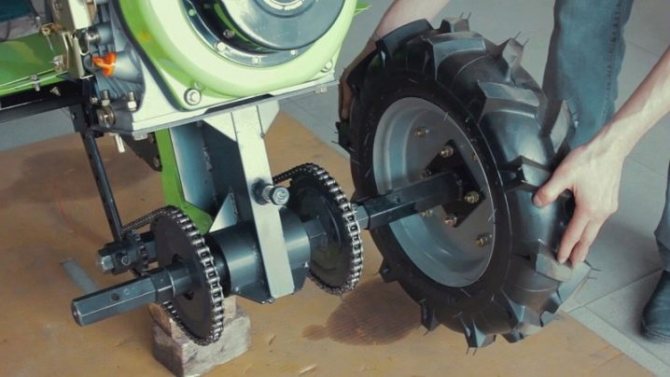
Plow installation
Thanks to the couplings (fastenings), the plow is mounted to the walk-behind tractor. It is better to do this work with an assistant, as it will require some effort and skills. First, the hitch is mounted on the walk-behind tractor, then connected to the plow mount with steel pins. The connection should not be installed tightly, a slight horizontal movement is necessary, otherwise when cultivating the soil, the walk-behind tractor will “slide” to the sides due to the unevenness of the soil.
After basic installation, the plow must be adjusted. You will have to tinker with the adjustment - the quality of plowing depends on it. Using fasteners, the plow is tilted so that its “heel” is directed horizontally to the ground. The adjusted walk-behind tractor is placed on the surface of the ground and the steering wheel is checked - it should be in the area of the plowman’s belt.
It remains to check whether the unit is ready for earthworks. It is necessary to make several test furrows with depth measurements and check the quality of the soil dump. Pay attention to the strip between the furrows - it should not be too wide (no more than 10 cm) or crossed by the plow.
Plowing the land is one of the most important agricultural activities. When preparing a site for planting in the spring or after harvesting, the soil must be dug up or plowed. This process helps fill the soil with oxygen, remove weeds, and thanks to it the snow stays on the arable land longer. You can use a shovel to dig up your garden. But this is quite labor-intensive work, especially if large areas of land have to be cultivated. Nowadays, thanks to the development of technology, this task can be made easier by using a walk-behind tractor.
The walk-behind tractor is a universal device. With its help, they carry out basic agricultural work: plowing the land, planting root crops, weeding seedlings, hilling potatoes, harvesting crops, and mowing grass.
Plowing the site
It’s not difficult to figure out how to plow with a walk-behind tractor and a plow. To do this, you need to roll out the device to the place where the land is plowed and along the first row, where loosening will take place, pull a cord that you can use to guide it - the plow pulls to the right, and it is quite difficult to make the first row level without auxiliary means.
The handle of the equipment should be turned to the left in order to walk across an area of land that has not yet been plowed. Before starting the main plowing, it is necessary to carry out control plowing of the soil - walking to the opposite end of the site at low speed.
This is necessary to check whether the tiller is adjusted correctly and whether the furrow depth is sufficient (it should be 15–20 cm). We place the right lug in the row-crop furrow, engage first gear, tilt the device to the right and begin to move. Having completed the first control pass, we turn the device 180 ° so that the right wheel of the walk-behind tractor is on the opposite side to the already plowed row, and move in the opposite direction. After the second pass, we evaluate the depth of the furrow. If the depth is not sufficient or the furrow is too deep, the plow must be adjusted again.
How to plow with a walk-behind tractor correctly
The engine is started, you can start plowing. To begin work, the walk-behind tractor is brought to the site. The boundaries of the first furrow are marked with a taut twine. The control knobs should be turned to the left to operate the unit from unplowed ground. The first furrow is made at low speed. This must be done carefully, without losing the orientation cord. Having reached the end of the site, check the plowing depth. It should be within 15-20 cm.
We suggest you read What to do with frozen pumpkin. Frozen pumpkin dishes: recipes for every taste
After this, the right wheel is placed in the furrow, engaged in first gear and continues to plow. The equipment is easy to use and the skill appears quickly. If the plowing depth is not satisfactory, you need to adjust the plow. When plowing, you need to constantly monitor the wheel in the furrow; it should not go beyond its limits.
Sometimes the motor overheats. In this case, it needs to be turned off and cooled. When the soil is plowed, it is filled with oxygen. This affects the future harvest. Autumn plowing is useful. Plow with a walk-behind tractor before winter. In the spring, it remains to dig up some areas in the corners of the garden. For plowing, it is better to use medium and heavy class products.
